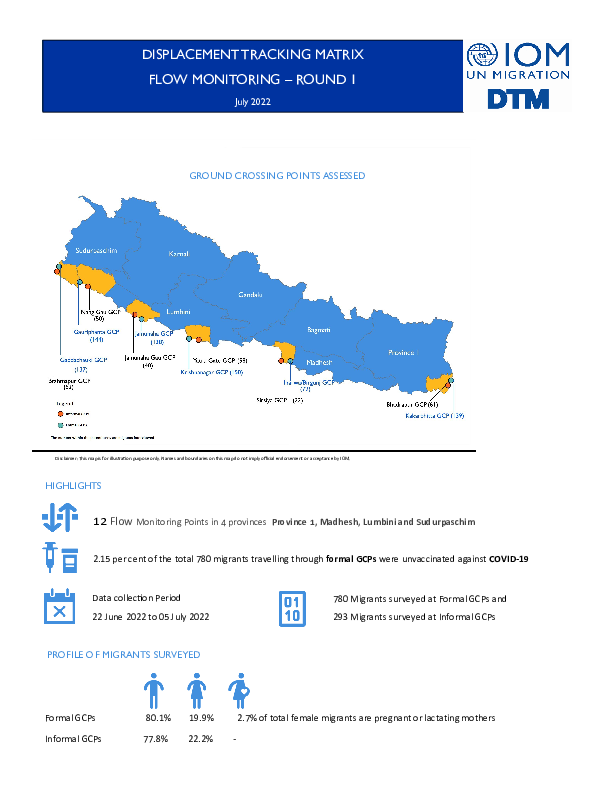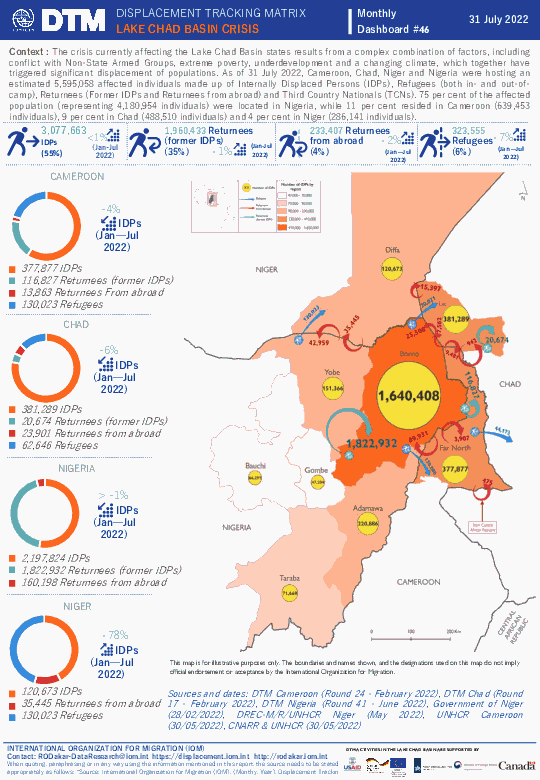-
Countries
-
Data and Analysis
-
Special Focus
-
Crisis Responses

Contact
DTM Nigeria, AllUsersInDTMNigeria@iom.int
Language
English
Location
Nigeria
Period Covered
Aug 01 2022
Aug 07 2022
Activity
- Mobility Tracking
- Event Tracking
Nigeria's north-central and north-west zones are afflicted with a multi-dimensional crisis rooted in long-standing tensions between ethnic and religious groups and involves attacks by criminal groups and banditry/hirabah (such as kidnapping and grand larceny along major highways). During the past years, the crisis has accelerated because of the intensification of attacks and has resulted in widespread displacement across the region.
Between 01 and 07 August, armed attacks by bandits in Kankara LGA of Katsina State and Kajuru LGA of Kaduna State, have led to new situation of forced displacement. During the period assessed, the DTM identified an estimated 1,631 individuals who were affected by attacks.

Contact
DTMAfghanistan@iom.int
Language
English
Location
Afghanistan
Period Covered
Mar 01 2022
Apr 30 2022
Activity
- Mobility Tracking
- Site Assessment
DTM has been conducting the Baseline Mobility Assessment in Afghanistan since 2016 to track mobility, provide information on population estimates, locations and geographic distribution of displaced and returnee populations, reasons for displacement, places of origin and periods of displacement. Vulnerabilities and multisectoral needs are covered in the Emergency Community- Based Needs Assessment (eCBNA) at the end of the report. Data is collected at the settlement level, through focus group discussions with community focal points and direct observations.
In Round 15, the DTM team witnessed a net increase in the number of all four target populations compared to the previous round (Round 14, collected in November and December 2021).

Contact
iomnepal@iom.int
Language
English
Location
Nepal
Period Covered
Jul 22 2022
Jul 05 2022
Activity
- Survey
- Flow Monitoring Survey
IOM Nepal collected data at 12 ground crossing points (GCPs) six formal and six informal, in an effort to better understand the migration movements between India and Nepal. The exercise intended to collate feedback from the migrants for improving COVID-19 related response and deliver multisectoral services, ultimately contributing to strengthen the GCPs’ capacities, providing safe and regular crossing for migrants. This exercise was conducted as a part of European Union Directorate General for European Civil Protection and Humanitarian Aid Operations funded “Effective Case Management by Strengthening Isolation Centres and Ground Crossing Points (GCPs) Management for Rapid Response and Preparedness Against COVID-19” project.
In total, 1,073 individuals (780 at formal GCPs and 293 at informal GCPs) were interviewed for the flow monitoring exercise in Province 1, Madhesh, Lumbini and Sudurpaschim Provinces. The report presents data collected on flows, demographics profile of migrants, services available to the migrants at the formal GCPs and suggestions for improvement of services. The survey at the informal GCPs was conducted to primarily assess the intensions of migrants for using informal GCPs. Since multisectoral services are only available at the formal GCPs, the survey does not include questions on services at informal GCPs.
Contact
DTMMali@iom.int
Location
Mali
Activity
- Mobility Tracking
- Baseline Assessment
Period Covered
Apr 01 2022 -Apr 30 2022
A baseline assessment is a sub-component of mobility tracking. It aims to collect data on IDP, migrant or returnee population presence in a defined administrative area of the country.
Population Groups
Survey Methodology
Unit of Analysis Or Observation
Type of Survey or Assessment
Keywords
Geographical Scope
Administrative boundaries with available data
The current dataset covers the following administrative boundaries

Contact
DTM Nigeria, AllUsersInDTMNigeria@iom.int
Language
English
Location
Nigeria
Period Covered
Oct 25 2021
Nov 29 2021
Activity
- Survey
As part of its DTM programme, IOM Nigeria has incorporated a return assessment that was conducted at household level in the northeastern states of Borno and Adamawa. While new displacements continue to occur across the region, the trend of continuously increasing returnee numbers presents a major challenge to humanitarian and development actors. To assist returnees, and to facilitate a sustainable return, it is essential to measure the socio-economic profiles and needs of the returnee populations, as well as their access to services, education and participation in governance and public affairs at the household level.
This assessment aims to better understand ‘return to communities of origin’ as a solution to internal displacement in north-east Nigeria. The primary objective is to assess the quality of return, and to assess if returnees are still experiencing needs that are linked to their previous displacement.

Contact
DTM Nigeria, AllUsersInDTMNigeria@iom.int
Language
English
Location
Nigeria
Period Covered
Aug 04 2022
Aug 07 2022
Activity
- Mobility Tracking
- Event Tracking
As part of the IDP relocation programme issued by the Borno State Government (BSG), Federal Training Centre Camp (Dalori I), located in the ward of Dalori in Konduga LGA, was closed between 04 August 2022 and 07 August 2022. Following this event, a rapid assessment was conducted by DTM (Displacement Tracking Matrix) field staff to identify the destinations of the 7,478 IDPs (1,496 households) residing in Dalori I Camp, and to inform the humanitarian community.
Following the closure of the camp, numerous IDPs integrated in host communities in the wards Bale Galitmari (205 individuals), Mairi (821 indiviuals) and Old Maiduguri (289 individuals) in Jere LGA, and the wards Bolori II (988 individuals), Gwange III (242 individuals) and Maisandari (720 individuals) in M.M.C. LGA. All these host community locations are considered to be part of the urban area of Maiduguri Town.
La région du Sahel central, et plus particulièrement la zone du Liptako Gourma, qui enjambe le Burkina Faso, le Mali et le Niger, est témoin d’une crise complexe qui comprend comme enjeux une compétition grandissante pour le contrôle de ressources; des bouleversements climatiques; une croissance démographique galopante; des niveaux élevés de pauvreté; l’absence d’opportunités économiques et un sentiment de désillusions quant au futur; des tensions communautaires; l’absence de présence étatique et le manque de services sociaux de base; et des violences provoquées par des réseaux de crime organisé et des groups armés non étatiques. La crise a engendré, en 2021, la mort de 5 000 personnes (au 31 décembre) et conduit à des déplacements de populations significatifs dans les quatre pays touches par la crise.
Au 31 juillet 2022, 2 641 697 individus étaient déplacés par la crise, y compris 2 437 354 Personnes déplacées internes (92% de la population affectée) et 204 343 réfugiés (8%). treize pour cent de la population déplacée (1 875 049 personnes) se trouvait au Burkina Faso, 16 pour cent au Mali (406 184), 8 pour cent au Niger (223 524) et 3 pourcent en Mauritanie (85 083).
The Central Sahel area, and in particular the Liptako Gourma region, which borders Burkina Faso, Mali and Niger, is affected by a complex crisis involving growing competition over dwindling resources; climatic variability; demographic pressure; high levels of poverty; disaffection and a lack of livelihood opportunities; communal tensions; the absence of state institutions and basic services; and violence related to organized crime and Non-State Armed Groups. The crisis has led to the death of an estimated 5,000 people in 2021 (as of 31 December) and triggered significant displacement of populations in the four affected countries.
As of 31 July 2022, 2,641,697 individuals have been displaced, including 2,437,354 Internally Displaced Persons (92% of the displaced population) and 204,343 Refugees (8% of the displaced population). Seventy-three per cent of the displaced population (1,902,150 individuals) were located in Burkina Faso, while 15 per cent resided in Mali (406,184 individuals), 8 per cent in Niger (223,524 individuals) and 3 per cent in Mauritania (85,083 individuals).
La crise dans le Bassin du lac Tchad est le résultat d’une combinaison complexe d’une multitude de facteurs, y compris un conflit armé impliquant des groups armés non étatiques, des niveaux extrêmes de pauvreté, un sous-développement persistent, et des bouleversements climatiques, qui ont conduit à des déplacements de populations importants. Au 31 juillet 2022, le Cameroun, le Tchad, le Nigeria et le Niger accueillaient 5 595 058 individus affectés par la crise, dont des Personnes déplacées internes (PDI), des réfugiés et des retournés (anciennes PDI et retournés de l’étranger). 75 pour cent d’entre eux (soit 4 180 954 personnes) se trouvaient au Nigéria, 11 pour cent au Cameroun (639 453 personnes), 9 pour cent au Tchad (488 510 personnes) et 5 pour cent au Niger (286 141 personnes).
The crisis currently affecting the Lake Chad Basin states results from a complex combination of factors, including conflict with Non-State Armed Groups, extreme poverty, underdevelopment and a changing climate, which together have triggered significant displacement of populations. As of 31 July 2022, Cameroon, Chad, Niger and Nigeria were hosting an estimated 5,595,058 affected individuals made up of Internally Displaced Persons (IDPs), Refugees (both in- and out-of-camp), Returnees (Former IDPs and Returnees from abroad) and Third Country Nationals (TCNs). 75 per cent of the affected population (representing 4,180,954 individuals) were located in Nigeria, while 11 per cent resided in Cameroon (639,453 individuals), 9 per cent in Chad (488,510 individuals) and 5 per cent in Niger (286,141 individuals).




